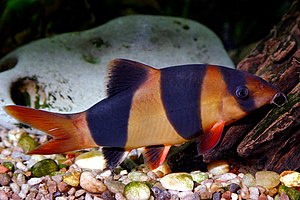Loach
| Loach | ||||||||||||
|---|---|---|---|---|---|---|---|---|---|---|---|---|

Loach ( Chromobotia macracanthus ) |
||||||||||||
| Systematics | ||||||||||||
|
||||||||||||
| Scientific name of the genus | ||||||||||||
| Chromobotia | ||||||||||||
| Kottelat , 2004 | ||||||||||||
| Scientific name of the species | ||||||||||||
| Chromobotia macracanthus | ||||||||||||
| ( Bleeker , 1852) |
The loach ( Chromobotia macracanthus ) is the only kind of genre Chromobotia within the family of loaches (Botiidae).
Chromo refers to the splendor of colors, botia goes back to a term used in Sumatra for this species. The species name macracanthus means "with large spines" (eye thorns).
distribution
Loaches are freshwater fish that are found in rivers. They live on the Great Sunda Islands of Borneo , Sumatra and Java and the Malaya peninsula , but also further north in Thailand and in Indian Brahmaputra . Exposed by humans, clown loaches are also found in Florida and near Vancouver, Canada .
features
The very distinctive black-orange body markings and colors serve as camouflage in the low-vegetation ground area of the fast-flowing home waters. Loaches are not schooling fish, but live in larger social groups that undertake joint spawning migrations. At the beginning of the rainy season , loaches migrate in large schools to the upper reaches of rivers and fast-flowing streams to spawn there. Young fish move with the current into the lower reaches and nutrient-rich estuaries. Loaches mainly eat animal, but also plant-based food.
With a maximum total length of around 30 centimeters, the loach is a stately freshwater fish and also more defensive against predators. Like all representatives of the subfamily Botiidae, this species also has a pair of pointed and sharp eye spines. A thorn lies in a skin pocket under each eye, can be folded out forwards by muscle movements and locked in place with a bone joint. Loaches can make cracking noises with their pharynx, which are used for intra-species communication. Since they, like all carp fish species, have Weber's apparatus on their heads , they are able to perceive sounds.
Adult females that are mature enough to spawn can be easily distinguished from adult males by their large body. There are no other external sexual characteristics.
Systematics
The loach was first scientifically described in 1852 by the Dutch naturalist Pieter Bleeker as Cobitis macracanthus . The type locality is the Kwanten River, near Palembang , in the large Sunda island of Sumatra, which belongs to Indonesia. Other synonyms are Botia macracanthus , Botia macracantha and Hymenophysa macracantha . In 2004, the Swiss ichthyologist Maurice Kottelat established the monotypical genus Chromobotia for this species, which differs from the other representatives of the genus Botia only in its striking body color .
Importance to humans
In their home country loaches are edible fish with tasty meat. They are caught with set and sink nets.
The loach has been one of the most popular aquarium fish worldwide since the mid-1930s . Mostly young catches are traded in the wild. Due to their size (30 cm) and their social behavior (lives in groups, forms territory with age), species-appropriate keeping is only possible in large or very large aquariums.
Commercial propagation after injection of pituitary hormones has only been common for a few years.
Web links
- Loach on Fishbase.org (English)
- CAS www.calacademy.org
literature
- P. Bleeker (1852): Diagnostische Beschrijvingen van nieuwe of weinig bekende vischsoorten van Sumatra . Tiental I - IV. Natuurkundig Tijdschrift voor Nederlandsch Indië, Volume 3, pp. 569–608.
- R. Fricke (1991): Types and historical materials in the fish collection of the Staatliches Museum für Naturkunde in Stuttgart. Part 1. The Bleeker collection . Stuttgart contributions to natural history, 471, pp. 1–85.
- M. Kottelat (2004): Botia kubotai, a new species of loach (Teleostei: Cobitidae) from the ataran River basin (Myanmar), with comments on botiinae nomenclature and diagnosis of a new genus . Zootaxa, 401, pp. 1-18.
Individual evidence
- ↑ GBIF: Chromobotia macracanthus (Bleeker, 1852) , accessed August 6, 2020.
- ^ Rüdiger Riehl / Hans A. Baensch ; Aquarium atlas; Mergus Verlag; 12th edition, 2000; P. 370; ISBN 3882442271